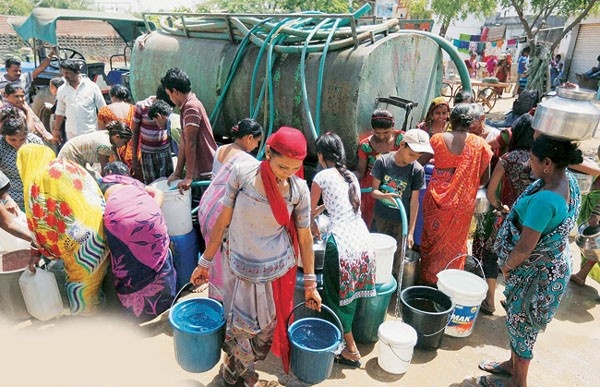
Nagpur: India has 18% of world’s population but has only 4% of water resources of the world. Annual per capita availability of water was 6042 cubic metres in 1947, 1816 in 2001 and 1545 in 2011, all primarily due to population explosion. It will be 1340 in 2025 and 1140 in 2050. Whereas the per capita water consumption is increasing due to a variety of factors like increased industrialization and irrigation, changes in life style and urbanization and so on. The agriculture sector is the biggest user of water followed by domestic and industrial sector.
Inter-state River Water Disputes in India
Most rivers of India are plagued with interstate disputes. Almost all the major rivers of the country are inter-state rivers and their waters are shared by two or more than two states.
After independence, demand for water had been increasing at an accelerated rate due to rapid growth of population, agricultural development, urbanisation, industrialisation, etc. These developments have led to several inter-state disputes about sharing of water of these rivers.
Following interstate river water disputes are worth mentioning.
(i) The Cauvery water dispute between Tamil Nadu, Karnataka and Kerala.
(ii) The Krishna water dispute between Maharashtra, Karnataka and Andhra Pradesh.
(iii) The Tungabhadra water dispute between Andhra Pradesh and Karnataka.
(iv) The Aliyar and Bhivani river water dispute between Tamil Nadu and Kerala.
(v) The Godavari river water dispute between Andhra Pradesh, Madhya Pradesh, Chhattisgarh, Orissa and Karnataka.
(vi) The Narmada water dispute between Gujarat, Maharashtra, Madhya Pradesh and Rajasthan.
(vii) The Mahi river dispute between Gujarat, Rajasthan and Madhya Pradesh.
(viii) The Ravi and Beas river water dispute between Punjab, Haryana, Himachal Pradesh, Rajasthan, Jammu and Kashmir and Delhi.
(ix) The Sutlej-Yamuna Link canal dispute between Punjab, Haryana and Rajasthan.
(x) The Yamuna river water dispute between Uttar Pradesh, Haryana, Himachal Pradesh, Punjab, Rajasthan, Madhya Pradesh and Delhi.
(xi) The Karmanasa river water dispute between Uttar Pradesh and Bihar.
(xii) The Barak river water dispute between Assam and Manipur.
India receives an average of 4,000 billion cubic meters of rainfall every year. Only 48% of rainfall ends up in India’s rivers. Due to lack of storage and crumbling infrastructure, only 18% can be utilized. Rainfall is confined to the monsoon season, June through September, when India gets, on average, 75% of its total annual precipitation.
Once again, due to India’s storage crunch the government is unable to store surplus water for the dry season. Such uneven seasonal distribution of rainfall has not stimulated the development of better capturing and storing infrastructure, making water scarcity an unnecessary yet critical problem.
Water levels at 91 major reservoirs nationwide are the lowest in a decade – no more than 29 per cent, according to the Central Water Commission (CWC). The water levels at Indian reservoirs are 71 per cent of last year, or 74 per cent of average storage over the last decade, the CWC data reveal. The 91 major reservoirs contain 157.8 billion cubic metre (BCM) of water; the capacity of these reservoirs is 250 BCM. Another 400 BCM water is available for irrigation in India through groundwater.
A research group in Singapore warned that Himalayan river basins in China, Bangladesh, India and Nepal will face massive water depletion within 20 years, leading to a decline in food and mass migration. Due to natural reasons like glacial melting, the four countries would lose almost 275 billion cubic metres of annual renewable water in the next two decades, more than the total amount of water available in Nepal at present. India-based Strategic Foresight Group said in a report, “We are certainly heading for a catastrophe that is going to happen in the next 20 – 25 years and not later.” Water scarcity and effects like desertification and soil erosion would bring rice and wheat yields in China and India down by as much as 50 per cent by 2050, the researchers warn. This will lead to massive food imports by these two countries with attendant price escalation and non-availability. Water depletion in the river basins would displace millions of people in the four countries by 2050.
Three years ago thousands of villages in Maharashtra’s Marathwada were facing record-breaking drought. They depended solely on water from state-supplied tankers, with the town of Latur supplying water to its people once in three weeks. A n year earlier, the Latur district administration, fearing violence over water, imposed restrictions on assembly. Fodder camps in parched rural Maharashtra shelter not just cattle but hundreds of human families. The government is now recommending that towns and cities stop water supply to swimming pools.
Madhya Pradesh (MP) is bracing for drought and the government is preparing to send tankers to villagers. In Bundelkhand, spread across MP and Uttar Pradesh, there hasn’t been water to sow the winter crop, agricultural productivity has halved and people find it hard to buy salt. In Odisha, farmers have broken embankments of public lakes to save crops.
Inequities in water availability are a reflection of unequal development within the country. 13% of Delhi’s citizens, of the nation’s capital, do not get water supply every day; 40% of households in Madhya Pradesh are not supplied even 40 litres per day. Even if we achieve the Millennium Development Goal of halving the population without access to drinking water and sanitation by 2020, 244 million people in rural India and 90 million in urban India will still not have access to safe, sustainable water supply. India, as the poorest country in the world in terms of number of people, would also have the correspondingly highest number of people without access to water in absolute terms. Within metropolitan cities, the condition of slum-dwellers is not just bad in terms of quantity and quality; volume for volume, these marginalised sections pay far more for a bucket of water than those who have piped supply. Even in metropolitan cities, leaving out a few posh localities, getting piped water round the clock is a luxury.
Water is both an important input for many different manufacturing and industrial sectors and used as a coolant for machines, such as textile machines. Cheap water that can be rapidly pumped from underground aquifers has been a major factor in the success of India’s economic growth.
The demand for drinking water is divided between the urban and rural populations, and comprises about 4-6% of total water demand. Due to the amenities of typical urban life, such as flush toilets and washing machines, people living in cities tend to lead more water intensive lives. The urban population has doubled over the past 30 years, now representing 30% of India’s total population and is expected to reach 50% of the total population by 2025.
Population growth is going to accelerate the water crisis in India, especially as more and more people move into the cities and become part of the middle class. Because the river water is too polluted to drink and the government is unable to consistently deliver freshwater to the cities, many urban dwellers are turning to groundwater, which is greatly contributing to the depletion of underground aquifers. Rural citizens face a similar crisis. Currently 30% of the rural population lack access to drinking water, and of the 35 states in India, only 7 have full availability of drinking water for rural inhabitants.
Depleting ground water level may be a real worry if one looks at the future demand of water in India. As per the estimates of Central Water Commission (CWC) the country would need 1,180 billion cubic meter (BCM) of water annually by 2050. India has, at present, annual potential of 1,123 BCM of ‘utilizable’ water with 690 BCM coming from surface water resources and remaining 433 BCM from ground water resources. But these resources are showing downward trend alarmingly and continuously.
The fall in water levels in wells from 2003 to 2013 in terms of percentage are:
Tamil Nadu – 76
Punjab – 72
Kerala – 71
Karnataka – 69
Meghalaya – 66
Haryana – 65
West Bengal – 64
Delhi – 62
Depleting ground water level may be a real worry if one looks at the future demand of water in India. In view of the above projections the country would not be able to meet its future demand unless it recharges its aquifers adequately and uses water more efficiently and judiciously. This is a very tall order in our lackadaisical society.
The dependence of irrigation on groundwater increased with the onset of the ‘Green Revolution,’ which depended on intensive use of inputs such as water and fertilizers to boost farm production. Rather than extending surface water irrigation to unirrigated regions, policymakers began providing incentives for groundwater extraction. Private groundwater irrigation was facilitated by extending credit and subsidies for irrigation equipment. However, the centrepiece of government policy has been the massive subsidy provided on electricity supply. Low power tariffs led to excessive water usage, leading to a sharp fall in water tables. The rush to grow cash crops in recent years has only exacerbated the crisis.
India’s agricultural sector currently uses about 90% of total water resources. Irrigated agriculture has been fundamental to economic development, but unfortunately it caused groundwater depletion. Due to water pollution in rivers, India draws 80% of its irrigation water from groundwater. As water scarcity becomes a bigger and bigger problem, rural and farming areas will most likely be hit the hardest. Thus far, food security has been one of the highest priorities for politicians
Surface water — with rivers as its main source — is being relentlessly utilised through dams. These dams have robbed some rivers of their usual water flow, while diverting the course of others. The use of surface water is also affected adversely by dams. With over 5,000 dams, India is behind only China and US on this count. While facilitating irrigation and electricity generation, the dams are adversely affecting water quality in the country.
What about pollution in the rivers? Originating from the Yamunotri glacier in the Lower Himalayas, Yamuna is the largest tributary of the Ganges. It flows through several states of North India, and creates a very fertile and alluvial region at its confluence with the Ganges. By far, it is the second most polluted river in India, after the Ganges. Millions of tons of household garbage is discharged into the river each day, and every attempt to curb this has failed till date. Traces of poisonous insecticides have also been found in the Yamuna, recently. Extreme urbanization and soil erosion are also serious causes of concern.

Y Udaya Chandar
Considered to be the holiest river in Hinduism, the Ganges originates at the Gangotri glacier in the western Himalayas and flows through the Gangetic plain of North India, and then enters Bangladesh, where it meets the Bay of Bengal. In 2007, Ganges was ranked as one of the five most polluted rivers in the world. Owing to its religious association, the contaminants polluting this river are numerous and varied. The pollutants range from toxic industrial waste to sewage to plastics and innumerable religious offerings made to the river each day. Added to this, people bathe in the ‘holy’ waters, wash their clothes, cook on its banks, and dispatch dead bodies. According to a recent study by the Indian Council of Medical Research (ICMR), the Ganges is so full of toxic pollutants that people staying close to its banks are more susceptible to cancer than anywhere else in India.
The rivers in the country are not useful mainly because of pollution. Because of the establishment of a large number of industrial cities on the bank of river Ganga like Kanpur, Allahabad, Varanasi and Patna, countless tanneries, chemical plants, textile mills, distilleries, slaughterhouses, and hospitals prosper and grow along this and contribute to the pollution of the Ganga by dumping untreated waste into it. Industrial effluents are about 12% of the total volume of effluent reaching the Ganga. Although a relatively low proportion, they are a cause for major concern because they are often toxic and non-biodegradable. During festival seasons, over 70 million people bathe in the Ganga over a few weeks to cleanse themselves from their past sins. Some materials like food, waste or leaves are left in the Ganga for ritualistic reasons. Many poor people leave the dead bodies of their relatives in the river. Similarly dead bodies of animals float in the river.
Number of rivers defined as ‘polluted’ in India has risen from 121 to 275 in the last five years, with increased levels of sewage a primary cause, as per the Central Pollution Control Board (CPCB), India. More than half the rivers in India are polluted, with the developing economic power unlikely to meet demand for fresh water from its still-growing population unless dramatic measures are taken, a new report by government scientists has said. A primary cause is the quantity of sewage generated by cities and towns along polluted stretches the CPCB’s report found. “In view of population increase, demand for freshwater for all uses will be unmanageable,” it said. The sewage generated from 650 cities and towns situated along the 302 polluted river stretches has also increased from 38,000 Million Litres per Day (MLD) in 2009 to 62,000 MLD in 2015, the assessment says. Significantly, though relative capacities of the Sewage Treatment Plants have not increased, there has been a massive rise in sewage.
While the treatment capacity of the plants stood at 11,800 MLD in 2009, it has risen to 24,000 MLD. The gap in the treatment capacity has only widened with 26,200 MLD in 2009 to 38,000 MLD in 2015. Based on the Biochemical Oxygen Demand (BOD) levels, the 302 polluted river stretches have been bracketed into five priority classes. The CPCB has placed 34 rivers with BOD values exceeding 30 mg per litre in Priority Class I that means they require urgent attention.
The pollutants in the rivers include oils, greases, plastics, plasticizers, metallic wastes, suspended solids, phenols, toxins, acids, salts, dyes, cyanides, pesticides etc. Many of these pollutants are not easily susceptible to degradation and thus cause serious pollution problems.
Contamination of ground water and fish-kill episodes are the major effects of the toxic discharges from industries. Discharge of untreated sewage and industrial effluents leads to a number of conspicuous effects on the river environment. The impact involves gross changes in water quality viz. reduction in dissolved oxygen and reduction in light penetration that’s tends loss in self purification capability of river water; the river water pollution leads to hazardous impact on aquatic animals and plants. Some studies show alarming condition of river pollution implications. Contamination by synthetic organic pollutants is a more recent phenomenon which is even more difficult to trace for lack of appropriate monitoring.
The catastrophe is looming large in the water availability situation in the country. People know what to do about it but no one is able to force the people to do the right thing. Even the highly educated industrialists are not doing what they ought to do. Let us hope that better sense prevails in the countrymen very shortly.
(The writer is a retired Colonel from the Indian Army. A passionate student of Sociology with a PhD in the subject. Author of many books.)
—Y Udaya Chandar














